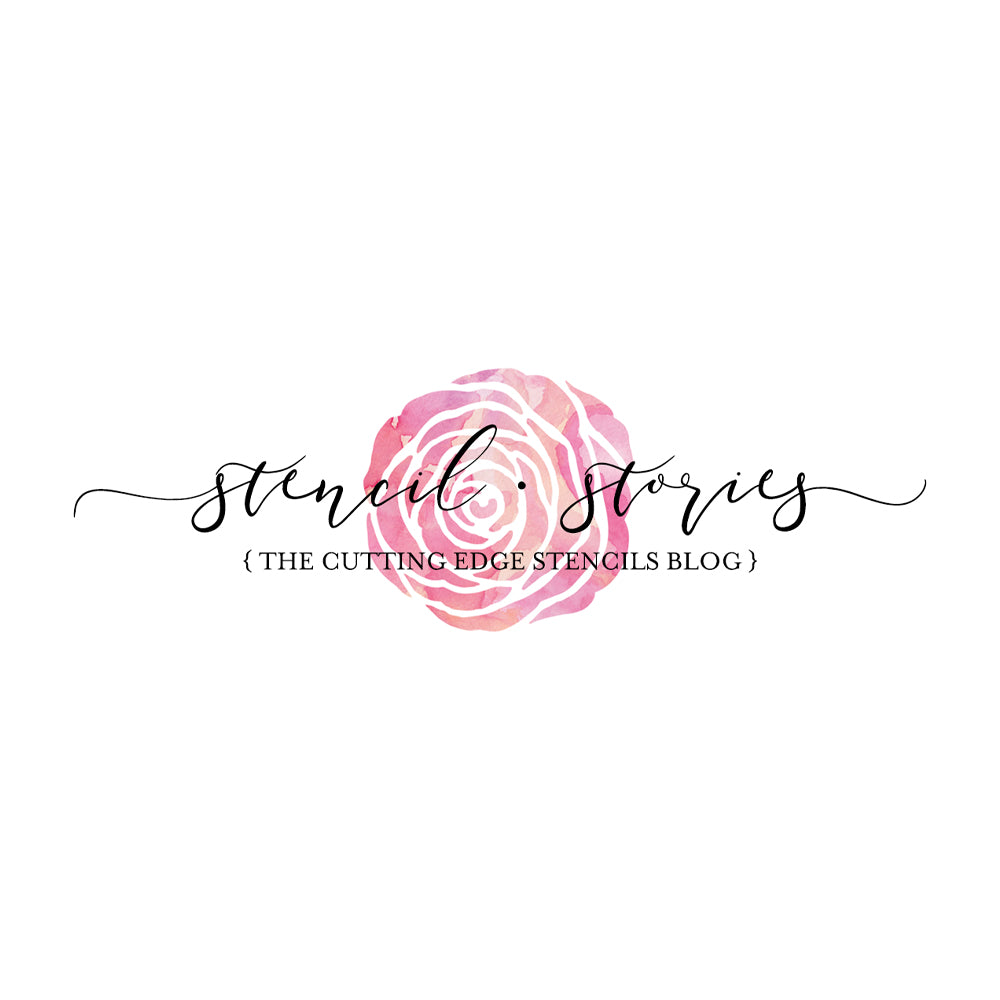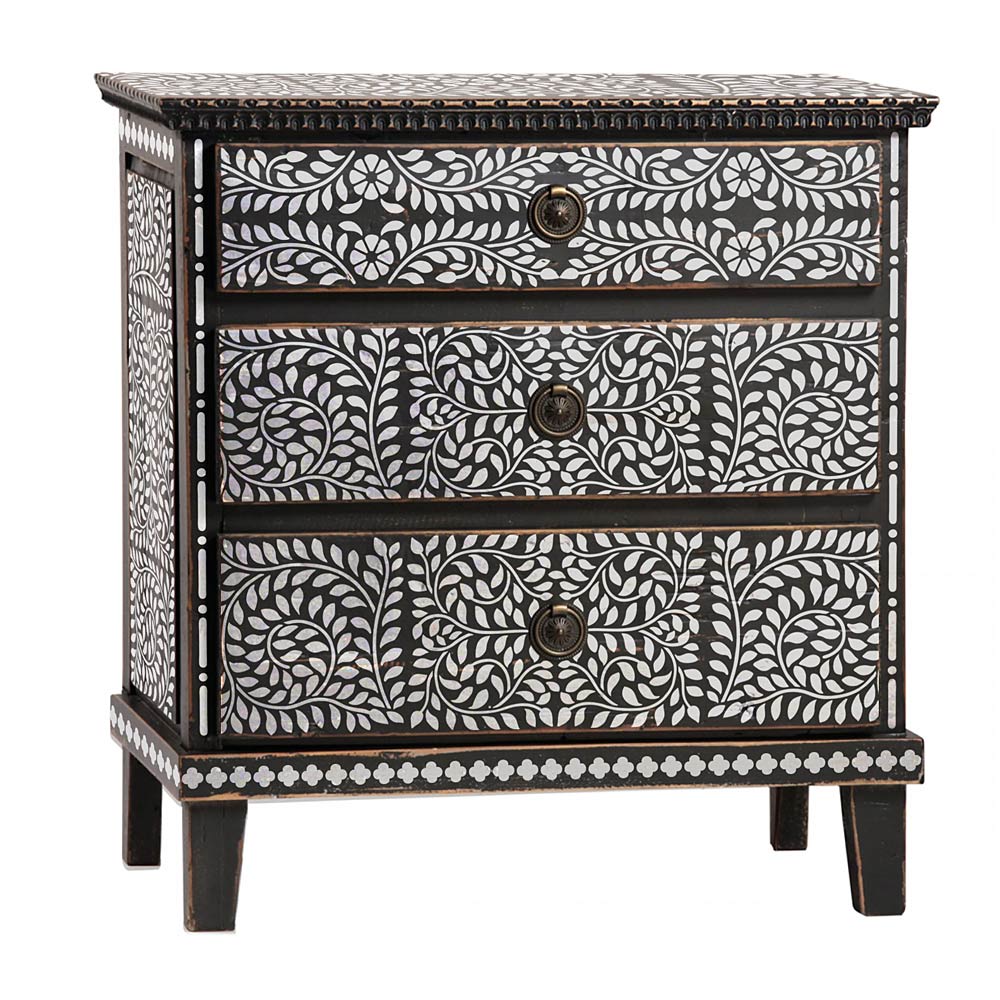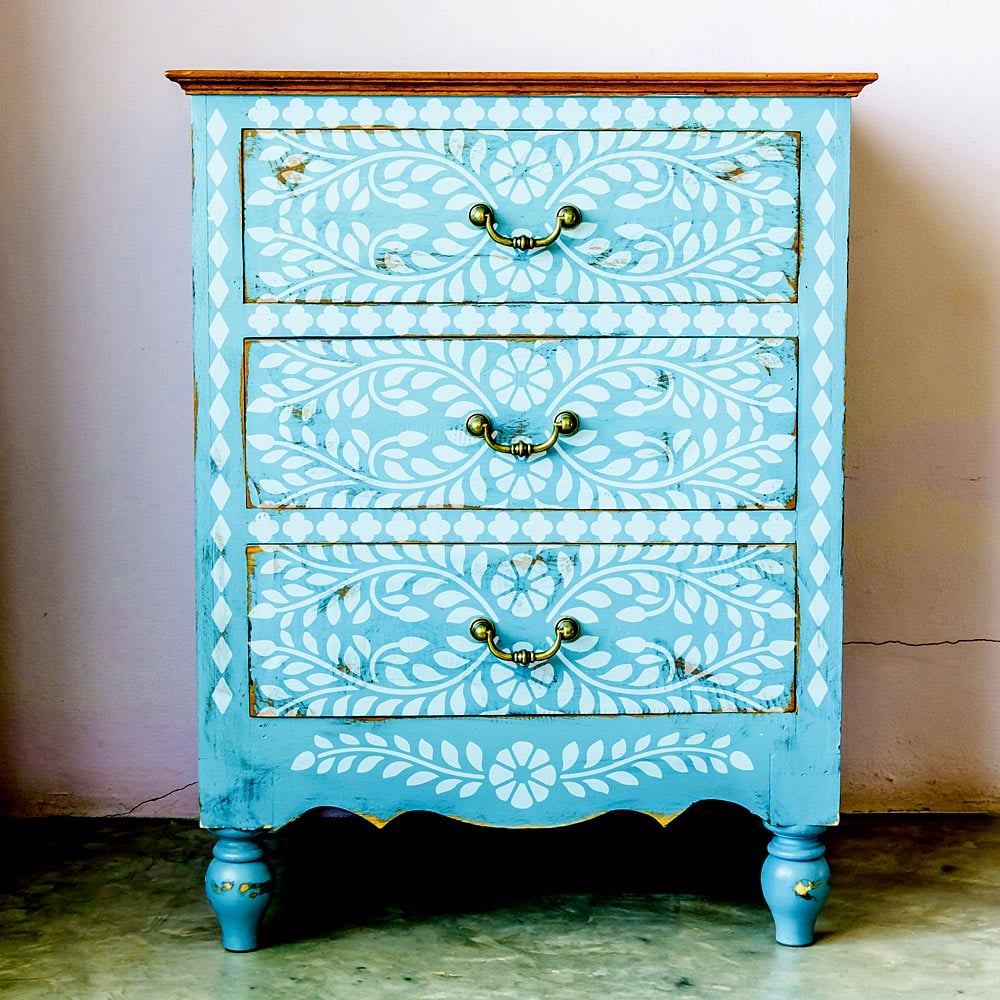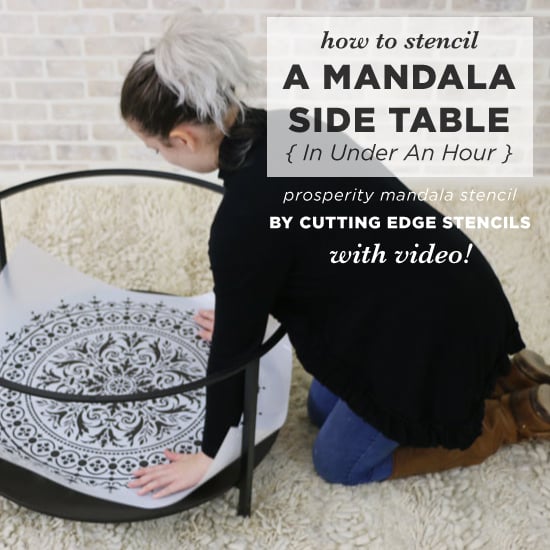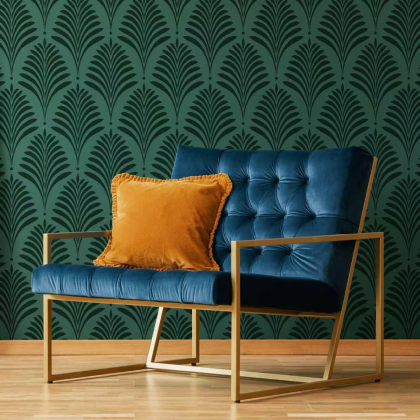Everything You Need to Know for a DIY Stenciled Potting Bench
Upcycled Stencil Project Using an Inlay Stencil Kit
Hello again, Cutting Edge Stencil DIYers! We have a gorgeous repurposed stencil project for you this week using an inlay stencil kit! Potting benches are the hottest trend right now! They make the perfect accent piece inside a greenhouse or in the garden and this stenciled masterpiece can be used as a workspace too! Check it out!

Before we get started check out the video:
The star of the show in this DIY stencil project is the large Asha Bone Inlay Stencil Kit! With thirteen different stencils, you can mix and match the various inlay designs however you want! Here’s a full list of supplies used for this stencil project:
 Paint Materials
Paint Materials
- Stix primer (or any good adhesive primer)
- Benjamin Moore Nob Hill and Navajo White paint
- Antiquing glaze (raw umber acrylic paint + faux crème clear or similar glazing medium)
- Chalk powder (optional but gives better paint adhesion and is easier to sand and distress)
- Blue painter’s tape
- Spray adhesive
- Chalk pencil (for stencil pattern layout)
- Water-based polyurethane
Brushes
Tools
- Hammer
- Saw
- Flathead screwdriver
- 120 grit sandpaper
Accessories (optional)
- Doorknobs
- Hooks
- Shelf brackets
The Cutting Edge Team upcycled two pieces of old furniture for this DIY project: a server and a door.

 Because of the server’s unique shape, Greg removed the sides and backsplash of the server so it would match the width of the door. We actually were able to repurpose the backsplash! We’ll show you how we did it later! First, Greg took out the two side drawers and set them aside. A few measurements later, he cut off the sides of the server to match the width of the door.
Because of the server’s unique shape, Greg removed the sides and backsplash of the server so it would match the width of the door. We actually were able to repurpose the backsplash! We’ll show you how we did it later! First, Greg took out the two side drawers and set them aside. A few measurements later, he cut off the sides of the server to match the width of the door.
 Greg attached the front of the door to the back of the server using wood screws. Next, Erika masked off the windows of the door to prevent paint bleed onto the glass. After lightly sanding and dusting off our new potting bench, she applied two coats of Stix primer. Any good adhesive primer will work! Next, she applied 2 coats of Benjamin Moore Nob Hill, waiting for each coat to dry before proceeding with the next.
Greg attached the front of the door to the back of the server using wood screws. Next, Erika masked off the windows of the door to prevent paint bleed onto the glass. After lightly sanding and dusting off our new potting bench, she applied two coats of Stix primer. Any good adhesive primer will work! Next, she applied 2 coats of Benjamin Moore Nob Hill, waiting for each coat to dry before proceeding with the next.
 Erika and Elyse then began the stenciling portion of this DIY project. They both used a Number 3 stencil from the large Asha Bone Inlay Stencil Kit and proceeded to stencil the border of the windows as well as the door itself. They selected the Number 3 stencil for the border of the door but, you can choose any of the stencil patterns that best suits your taste.
Erika and Elyse then began the stenciling portion of this DIY project. They both used a Number 3 stencil from the large Asha Bone Inlay Stencil Kit and proceeded to stencil the border of the windows as well as the door itself. They selected the Number 3 stencil for the border of the door but, you can choose any of the stencil patterns that best suits your taste.
 Erika and Elyse stenciled the legs of the potting bench using various stencils from the large Asha Inlay kit. Elyse then continued with the same stencil pattern around the front and sides of the potting bench. The goal was to have little to no open spaces anywhere and let the stencil do all the talking!
Erika and Elyse stenciled the legs of the potting bench using various stencils from the large Asha Inlay kit. Elyse then continued with the same stencil pattern around the front and sides of the potting bench. The goal was to have little to no open spaces anywhere and let the stencil do all the talking!

 Can you spot where we put the backsplash now? It ended up on top of the door to bring a beautiful curve to the piece! Erika and Elyse continued the border onto the top piece so it looked as if it was always there! They both used a stencil brush and the Number 4 stencil from the Asha Bone Inlay Stencil Kit to stencil in between the borders. In the center of the top piece, Erika switched over to a 2” dense foam roller and a Number 10 stencil. A dense foam roller works great for more open spaces and stencil brushes are perfect for smaller, tighter spaces.
Can you spot where we put the backsplash now? It ended up on top of the door to bring a beautiful curve to the piece! Erika and Elyse continued the border onto the top piece so it looked as if it was always there! They both used a stencil brush and the Number 4 stencil from the Asha Bone Inlay Stencil Kit to stencil in between the borders. In the center of the top piece, Erika switched over to a 2” dense foam roller and a Number 10 stencil. A dense foam roller works great for more open spaces and stencil brushes are perfect for smaller, tighter spaces.
 Erika mapped out what stencils she would use for the surface and shelves of the potting bench, varying the order of the stencils to create a unique look every time! She used a chalk pencil to outline the most prominent parts of the stencil design to remember the exact placement. She then stenciled the design with a stencil brush, repeating the process until the bottom half of the potting bench was complete!
Erika mapped out what stencils she would use for the surface and shelves of the potting bench, varying the order of the stencils to create a unique look every time! She used a chalk pencil to outline the most prominent parts of the stencil design to remember the exact placement. She then stenciled the design with a stencil brush, repeating the process until the bottom half of the potting bench was complete!

 Finally, Erika stenciled the drawer of the server and slid it back into its original position.
Finally, Erika stenciled the drawer of the server and slid it back into its original position.
 After the stenciling was complete, the potting bench looked gorgeous! However, the Cutting Edge Team wanted to take it one step further and give this piece a more rustic look! Greg mixed up an antiquing glaze intended to slightly age the potting bench. Don’t be intimidated by the sound of antiquing glaze, it’s just a mix of raw umber acrylic paint and glazing medium! He evenly applied the glaze using a 2.5” nylon brush and then using a roll of paper towels, he wiped most of it off the flat areas, leaving the glaze in the cracks and corners to emulate a beautiful aged patina!
After the stenciling was complete, the potting bench looked gorgeous! However, the Cutting Edge Team wanted to take it one step further and give this piece a more rustic look! Greg mixed up an antiquing glaze intended to slightly age the potting bench. Don’t be intimidated by the sound of antiquing glaze, it’s just a mix of raw umber acrylic paint and glazing medium! He evenly applied the glaze using a 2.5” nylon brush and then using a roll of paper towels, he wiped most of it off the flat areas, leaving the glaze in the cracks and corners to emulate a beautiful aged patina!

 Next, Greg took some of the antiquing glaze and diluted it with some water. He dipped the tip of the stencil brush into the diluted glaze and dragged his finger over the top of the brush to produce a spattering effect. This is also known as fly specking! This is just another layer in the antiquing process that adds so much to the patina effect!
And now another great furniture antiquing tip! Greg took a chip brush and some brown acrylic paint and applied it to the edges of our potting bench. Make sure there isn’t too much paint on the brush. We call this technique dry brushing. It gives the appearance that the paint has naturally worn off the edges! Any brown paint that’s in a wood tone will work for this technique. It’s so much easier than sanding off all the layers of paint to reveal the wood underneath.
Next, Greg took some of the antiquing glaze and diluted it with some water. He dipped the tip of the stencil brush into the diluted glaze and dragged his finger over the top of the brush to produce a spattering effect. This is also known as fly specking! This is just another layer in the antiquing process that adds so much to the patina effect!
And now another great furniture antiquing tip! Greg took a chip brush and some brown acrylic paint and applied it to the edges of our potting bench. Make sure there isn’t too much paint on the brush. We call this technique dry brushing. It gives the appearance that the paint has naturally worn off the edges! Any brown paint that’s in a wood tone will work for this technique. It’s so much easier than sanding off all the layers of paint to reveal the wood underneath.
 Then Greg applied a final coat of water-based polyurethane to protect the potting bench from the outdoor elements. Finally, he attached a door knob and drawer knobs to add a little bit of flair!
Then Greg applied a final coat of water-based polyurethane to protect the potting bench from the outdoor elements. Finally, he attached a door knob and drawer knobs to add a little bit of flair!
 For the finishing touches, Greg added a small shelf to the top of the potting bench and hooks for gardening tools on the sides. The transformation is AMAZING! What once was trash is now a stenciled statement piece! We could not love this stenciled treasure more!
For the finishing touches, Greg added a small shelf to the top of the potting bench and hooks for gardening tools on the sides. The transformation is AMAZING! What once was trash is now a stenciled statement piece! We could not love this stenciled treasure more!



Love this DIY stenciled potting bench?
Thanks for reading and happy stenciling!
Elyse and the Cutting Edge Stencils Team
 Before we get started check out the video:
The star of the show in this DIY stencil project is the large Asha Bone Inlay Stencil Kit! With thirteen different stencils, you can mix and match the various inlay designs however you want! Here’s a full list of supplies used for this stencil project:
Before we get started check out the video:
The star of the show in this DIY stencil project is the large Asha Bone Inlay Stencil Kit! With thirteen different stencils, you can mix and match the various inlay designs however you want! Here’s a full list of supplies used for this stencil project:
 Paint Materials
Paint Materials

 Because of the server’s unique shape, Greg removed the sides and backsplash of the server so it would match the width of the door. We actually were able to repurpose the backsplash! We’ll show you how we did it later! First, Greg took out the two side drawers and set them aside. A few measurements later, he cut off the sides of the server to match the width of the door.
Because of the server’s unique shape, Greg removed the sides and backsplash of the server so it would match the width of the door. We actually were able to repurpose the backsplash! We’ll show you how we did it later! First, Greg took out the two side drawers and set them aside. A few measurements later, he cut off the sides of the server to match the width of the door.
 Greg attached the front of the door to the back of the server using wood screws. Next, Erika masked off the windows of the door to prevent paint bleed onto the glass. After lightly sanding and dusting off our new potting bench, she applied two coats of Stix primer. Any good adhesive primer will work! Next, she applied 2 coats of Benjamin Moore Nob Hill, waiting for each coat to dry before proceeding with the next.
Greg attached the front of the door to the back of the server using wood screws. Next, Erika masked off the windows of the door to prevent paint bleed onto the glass. After lightly sanding and dusting off our new potting bench, she applied two coats of Stix primer. Any good adhesive primer will work! Next, she applied 2 coats of Benjamin Moore Nob Hill, waiting for each coat to dry before proceeding with the next.
 Erika and Elyse then began the stenciling portion of this DIY project. They both used a Number 3 stencil from the large Asha Bone Inlay Stencil Kit and proceeded to stencil the border of the windows as well as the door itself. They selected the Number 3 stencil for the border of the door but, you can choose any of the stencil patterns that best suits your taste.
Erika and Elyse then began the stenciling portion of this DIY project. They both used a Number 3 stencil from the large Asha Bone Inlay Stencil Kit and proceeded to stencil the border of the windows as well as the door itself. They selected the Number 3 stencil for the border of the door but, you can choose any of the stencil patterns that best suits your taste.
 Erika and Elyse stenciled the legs of the potting bench using various stencils from the large Asha Inlay kit. Elyse then continued with the same stencil pattern around the front and sides of the potting bench. The goal was to have little to no open spaces anywhere and let the stencil do all the talking!
Erika and Elyse stenciled the legs of the potting bench using various stencils from the large Asha Inlay kit. Elyse then continued with the same stencil pattern around the front and sides of the potting bench. The goal was to have little to no open spaces anywhere and let the stencil do all the talking!

 Can you spot where we put the backsplash now? It ended up on top of the door to bring a beautiful curve to the piece! Erika and Elyse continued the border onto the top piece so it looked as if it was always there! They both used a stencil brush and the Number 4 stencil from the Asha Bone Inlay Stencil Kit to stencil in between the borders. In the center of the top piece, Erika switched over to a 2” dense foam roller and a Number 10 stencil. A dense foam roller works great for more open spaces and stencil brushes are perfect for smaller, tighter spaces.
Can you spot where we put the backsplash now? It ended up on top of the door to bring a beautiful curve to the piece! Erika and Elyse continued the border onto the top piece so it looked as if it was always there! They both used a stencil brush and the Number 4 stencil from the Asha Bone Inlay Stencil Kit to stencil in between the borders. In the center of the top piece, Erika switched over to a 2” dense foam roller and a Number 10 stencil. A dense foam roller works great for more open spaces and stencil brushes are perfect for smaller, tighter spaces.
 Erika mapped out what stencils she would use for the surface and shelves of the potting bench, varying the order of the stencils to create a unique look every time! She used a chalk pencil to outline the most prominent parts of the stencil design to remember the exact placement. She then stenciled the design with a stencil brush, repeating the process until the bottom half of the potting bench was complete!
Erika mapped out what stencils she would use for the surface and shelves of the potting bench, varying the order of the stencils to create a unique look every time! She used a chalk pencil to outline the most prominent parts of the stencil design to remember the exact placement. She then stenciled the design with a stencil brush, repeating the process until the bottom half of the potting bench was complete!

 Finally, Erika stenciled the drawer of the server and slid it back into its original position.
Finally, Erika stenciled the drawer of the server and slid it back into its original position.
 After the stenciling was complete, the potting bench looked gorgeous! However, the Cutting Edge Team wanted to take it one step further and give this piece a more rustic look! Greg mixed up an antiquing glaze intended to slightly age the potting bench. Don’t be intimidated by the sound of antiquing glaze, it’s just a mix of raw umber acrylic paint and glazing medium! He evenly applied the glaze using a 2.5” nylon brush and then using a roll of paper towels, he wiped most of it off the flat areas, leaving the glaze in the cracks and corners to emulate a beautiful aged patina!
After the stenciling was complete, the potting bench looked gorgeous! However, the Cutting Edge Team wanted to take it one step further and give this piece a more rustic look! Greg mixed up an antiquing glaze intended to slightly age the potting bench. Don’t be intimidated by the sound of antiquing glaze, it’s just a mix of raw umber acrylic paint and glazing medium! He evenly applied the glaze using a 2.5” nylon brush and then using a roll of paper towels, he wiped most of it off the flat areas, leaving the glaze in the cracks and corners to emulate a beautiful aged patina!

 Next, Greg took some of the antiquing glaze and diluted it with some water. He dipped the tip of the stencil brush into the diluted glaze and dragged his finger over the top of the brush to produce a spattering effect. This is also known as fly specking! This is just another layer in the antiquing process that adds so much to the patina effect!
And now another great furniture antiquing tip! Greg took a chip brush and some brown acrylic paint and applied it to the edges of our potting bench. Make sure there isn’t too much paint on the brush. We call this technique dry brushing. It gives the appearance that the paint has naturally worn off the edges! Any brown paint that’s in a wood tone will work for this technique. It’s so much easier than sanding off all the layers of paint to reveal the wood underneath.
Next, Greg took some of the antiquing glaze and diluted it with some water. He dipped the tip of the stencil brush into the diluted glaze and dragged his finger over the top of the brush to produce a spattering effect. This is also known as fly specking! This is just another layer in the antiquing process that adds so much to the patina effect!
And now another great furniture antiquing tip! Greg took a chip brush and some brown acrylic paint and applied it to the edges of our potting bench. Make sure there isn’t too much paint on the brush. We call this technique dry brushing. It gives the appearance that the paint has naturally worn off the edges! Any brown paint that’s in a wood tone will work for this technique. It’s so much easier than sanding off all the layers of paint to reveal the wood underneath.
 Then Greg applied a final coat of water-based polyurethane to protect the potting bench from the outdoor elements. Finally, he attached a door knob and drawer knobs to add a little bit of flair!
Then Greg applied a final coat of water-based polyurethane to protect the potting bench from the outdoor elements. Finally, he attached a door knob and drawer knobs to add a little bit of flair!
 For the finishing touches, Greg added a small shelf to the top of the potting bench and hooks for gardening tools on the sides. The transformation is AMAZING! What once was trash is now a stenciled statement piece! We could not love this stenciled treasure more!
For the finishing touches, Greg added a small shelf to the top of the potting bench and hooks for gardening tools on the sides. The transformation is AMAZING! What once was trash is now a stenciled statement piece! We could not love this stenciled treasure more!


 Love this DIY stenciled potting bench?
Love this DIY stenciled potting bench?



